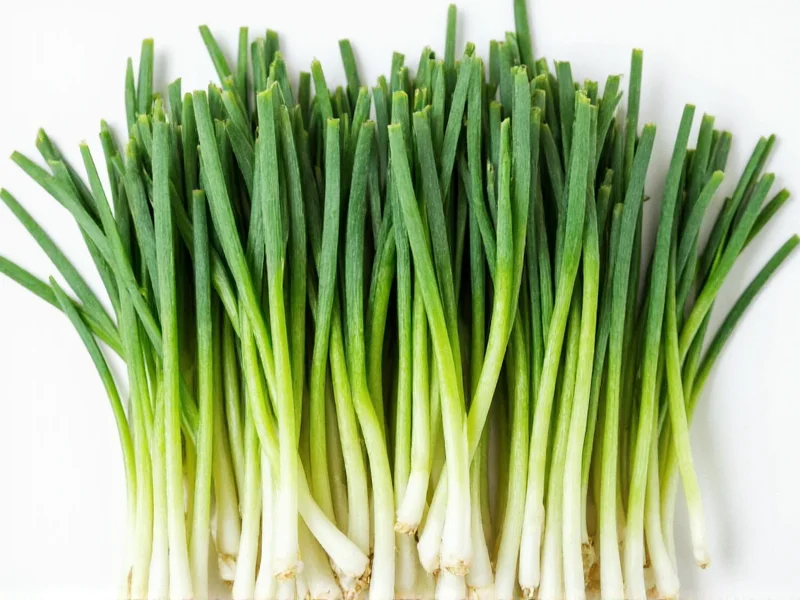Many home cooks and gardeners confuse green onions and chives because both appear in similar culinary contexts and share that characteristic onion-family aroma. However, these two ingredients have distinct botanical classifications, flavor profiles, and culinary applications that significantly impact how they should be used in cooking.
Botanical Classification: Understanding the Family Tree
Both plants belong to the Allium genus, which includes over 1,200 species of bulbous flowering plants. However, they diverge at the species level:
| Plant | Scientific Name | Common Names | Plant Type |
|---|---|---|---|
| Green Onions | Allium fistulosum | Scallions, spring onions, salad onions | Perennial with edible bulb |
| Chives | Allium schoenoprasum | Common chives, garden chives | Perennial grass-like plant |
Green onions are actually immature regular onions (Allium cepa) harvested before the bulb fully develops, or they can refer to the perennial bunching onion (Allium fistulosum) which never forms a large bulb. Chives, by contrast, are a separate species that never develops a bulb at all—they're essentially the green stalks only.
Physical Characteristics: Spotting the Difference
When standing side by side at the market, these plants show clear visual distinctions:
- Green onions have a noticeable white bulb at the base that gradually transitions to green stalks. The entire plant is edible, from root to tip.
- Chives grow in dense clumps of uniform, hollow green tubes without any bulb formation. They resemble thick grass more than traditional onions.
The confusion often arises because some grocery stores label green onions as "scallions" while others might mislabel young chive plants. True chives never develop that characteristic white bulb that green onions possess.
Flavor Profiles: Culinary Impact
The taste difference between these two ingredients significantly affects recipe outcomes:
- Green onions deliver a more pronounced onion flavor with varying intensity from the milder green tops to the stronger white bulb. They provide both texture and substantial onion flavor.
- Chives offer a much more delicate, subtle onion flavor with grassy notes. Their taste is significantly milder—about one-third the intensity of green onions.
Professional chefs consider these distinct flavor profiles when deciding which to use. Green onions work well in cooked dishes where their flavor can mellow and integrate, while chives are typically added at the end of cooking or used raw as a garnish to preserve their delicate flavor.
Culinary Applications: When to Use Which
Understanding the difference between green onions and chives prevents recipe disasters. Here's how top chefs utilize each:
Green Onions Best Uses
- Stir-fries and sautéed dishes (add white parts first, green parts later)
- Onion pancakes and savory pancakes
- Marinades and dressings requiring noticeable onion flavor
- As a garnish for Asian cuisine like pho or ramen
- Grilled as a side vegetable
Chives Best Uses
- Finishing touch on soups, baked potatoes, and omelets
- Infused in cream cheese, butter, or vinegar
- Salad garnishes where delicate flavor is preferred
- Herb blends like fines herbes
- As edible flowers (chive blossoms are edible and attractive)
When substituting one for the other, remember that green onions provide significantly more onion punch. If replacing chives with green onions, use only the green parts and reduce the quantity by half to avoid overpowering the dish.
Growing Differences: Garden Considerations
For home gardeners, understanding the difference between green onions and chives affects cultivation:
- Green onions grow from seeds or sets and mature in 60-80 days. They prefer full sun and well-draining soil. Bunching onions (Allium fistulosum) form perennial clumps.
- Chives grow from seeds or division of established clumps. They're hardy perennials that return yearly in most climates. Chives prefer slightly acidic soil and can tolerate partial shade.
Chive plants develop distinctive purple flower clusters that are both attractive and edible, while green onions never produce these ornamental blooms. This flowering habit provides another clear visual identifier between the two plants.
Storage and Shelf Life
Proper storage differs due to their structural differences:
- Green onions last 7-10 days when stored upright in a glass of water in the refrigerator, with a plastic bag loosely covering the greens.
- Chives are more delicate and typically last only 5-7 days when wrapped in a slightly damp paper towel inside a plastic bag.
For longer storage, both can be frozen—chopped and placed in ice cube trays with water or oil—but this works better for green onions than the more delicate chives.
Common Misconceptions Clarified
Several persistent myths cause confusion between these ingredients:
- Myth: "Spring onions" and "scallions" are different from green onions.
Fact: These are all terms for the same plant—immature onions harvested before bulb formation. - Myth: Chives are just young green onions.
Fact: They're completely different species that never develop into one another. - Myth: Garlic chives are the same as regular chives.
Fact: Garlic chives (Allium tuberosum) are a third distinct species with flat leaves and garlic notes.
Understanding these distinctions prevents culinary mistakes and helps you select the right ingredient for your recipes. The difference between green onions and chives matters most in dishes where their unique flavors play a starring role rather than just background notes.
When Substitution Makes Sense
While green onions and chives aren't interchangeable in all contexts, strategic substitution works in certain situations:
- Use green onion greens (not the bulb) as a substitute for chives when you need stronger flavor
- Substitute chives for green onions only in raw applications where mild flavor is acceptable
- Never substitute chives for green onions in recipes requiring the white bulb portion
- For cooked dishes, green onions provide better texture and flavor stability
Professional chefs often keep both in their kitchens because they serve different purposes. Recognizing the difference between green onions and chives elevates your cooking precision and helps achieve the intended flavor profile in recipes.











 浙公网安备
33010002000092号
浙公网安备
33010002000092号 浙B2-20120091-4
浙B2-20120091-4